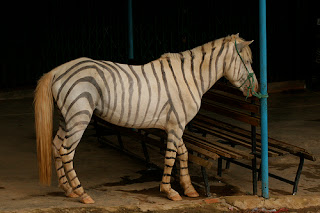True Wild Life | Zorse | The zorse is a cross between a zebra stallion and a domestic mare. It is also possible to use a zebra mare and a domestic stallion, but owners of valuable zebra mares don't want to waste a year of their breeding life producing a hybrid when they could be producing a zebra foal instead. The crosses were originally done in England and Africa to try to produce a domestic horselike animal that was resistant to diseases spread by the tse tse fly in Africa. Zebras have natural resistance, where domestic donkeys and horses do not. The experimental crosses were actually becoming popular until early in the 20th century when the auto displaced the horse and mule. At that point cross-breeding was largely abandoned. A revival of interest came in the early 1990s, with just about every breed of domestic horse imaginable being tried.
A zorse generally inherits the striping pattern and some of the conformation of the zebra sire with the size, colouration, and temperament of the domestic mare. Coarse bad tempered pony mares produce coarse bad tempered zonies. Mares of quality, especially Quarter horses and American Paint horses, produce some very beautiful zorses that have a good working attitude. If the mare has a pattern, such as pinto spotting or Appy spots, the zorse often will also. You only see the striping pattern on the pigmented areas, never on the white areas. Breeders avoid using gray mares because the zorse can inherit the graying gene and lose all his stripes in a few years! You can still see the stripes on the skin.
Like mules, zorses are born anatomically normal males or females. They exhibit normal breeding behaviour. But like mules they are sterile. Males should be gelded as early as a few months old to prevent dangerous studdy behaviour. A breeder in KY keeps two zorse mares in the pasture with his Paint stallion to keep him company. He has bred them both hundreds of times over the years but no offspring have ever resulted.
Zorses tend to be very hardy and live into their 30s with good care. Their temperaments are generally similar to those of their mothers, but like the zebra they do have a strong flight response. Because of this it's best for a first time hybrid owner to get a zedonk instead. When a zedonk startles he freezes up like a donkey rather than bolt blindly like a horse or zebra.




5 comments:
La 2eme image est vrais ou pas?ou c avec l'ombre
weird.....
Lets just keep crossbreeding and see what others weird creatures we can make. How pathetic.
half zebra + half horse = zorse
Since horse and Zebra are closely similar of its kind it's not impossible to breed their kinds and create a new they of specie. One way or another breeding Zebras and Horses could help grow the number of endangered zebras.
Post a Comment